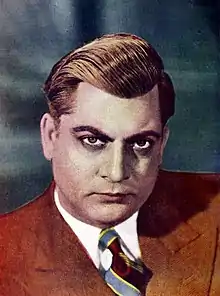Chandra Mohan (Hindi actor)
Chandra Mohan (24 July 1906 – 2 April 1949) was an Indian actor, known for his work in Hindi cinema in the 1930s and 1940s. He became known for his villainous roles in a number of critical and commercial successes.
Chandra Mohan Wattal | |
|---|---|
 Chandra Mohan in 1942 | |
| Born | 24 July 1906[1] |
| Died | 2 April 1949 (aged 42)[1] |
| Occupation | Actor |
| Years active | 1930–1949 |
Life and career
Born in Narsinghpur[1] in Madhya Pradesh, he was known for his large grey eyes, voice modulation and dialogue delivery. His eyes form the opening sequence in V. Shantaram's 1934 film Amrit Manthan, which was also his film debut.[2] It was the first film made in the newly established Prabhat Films studio, and made both in Hindi and Marathi. Mohan received acclaim for his role as Rajguru and went on to establish himself as a noted villain of the time.[3]
Mohan later appeared as Emperor Jehangir in Sohrab Modi's Pukar,[2] as Randhir Singh in Mehboob Khan's Humayun and as Seth Laxmidas, in Mehboob Khan's Roti.
One of his last appearances was in Ramesh Saigal's 1948 film Shaheed.[4] As Rai Bahadur Dwarka Nath, he played father to Ram, who was portrayed by Dilip Kumar. Mohan's character in this film initially supports the British Government but later favors the Freedom Struggle. Chandra Mohan's last movie was a religious movie Rambaan (1948), in which he played the role of the demon emperor Ravana.
He was the original choice to play the lead role in K. Asif's Mughal-e-Azam, but due to his untimely death the film had to be reshot after ten reels were shot with him as lead. The film was eventually released in 1960.[5][6]
Death
Mohan gambled and drank heavily and died penniless on 2 April 1949 at the age of 42 at his residence, Bilkha House, in Bombay.[1]
Filmography
- Amrit Manthan (1934)
- Dharmatma (1935)
- Amar Jyoti (1936)
- Jwala (1938)
- Pukar (1939)
- Geeta (1940)
- Bharosa (1940)
- Apna Ghar (1942)
- Roti (1942)
- Nauker (1943)
- Shakuntala (1943)
- Taqdeer (1943)
- Draupadi (1944)
- Mumtaz Mahal (1944)
- Raunaq (1944)
- Humayun (1945)
- Ramayani (1945)
- Shalimar (1946)
- Shaheed (1948)
- Rambaan (1948)
References
- "Chandra Mohan". Retrore. Archived from the original on 6 January 2019. Retrieved 29 February 2016.
- Garga, B D (1 December 2005). Art Of Cinema. Penguin Books Limited. pp. 131–. ISBN 978-81-8475-431-5. Archived from the original on 16 December 2019. Retrieved 11 October 2020.
- Banerjee, Srivastava (13 September 2013). One Hundred Indian Feature Films: An Annotated Filmography. Taylor & Francis. pp. 45–. ISBN 978-1-135-84105-8. Archived from the original on 1 April 2017. Retrieved 11 October 2020.
- Mahmood, Hameeduddin (1974). The Kaleidoscope of Indian Cinema. Affiliated East-West Press. p. 50.
- "How well do you know Mughal-e-Azam?". Rediff. 5 August 2010. Archived from the original on 1 December 2012. Retrieved 12 June 2012.
- Chopra, Anupama (2007). King of Bollywood: Shah Rukh Khan and the Seductive World of Indian Cinema. Grand Central Publishing. pp. 19–. ISBN 978-0-446-50898-8.